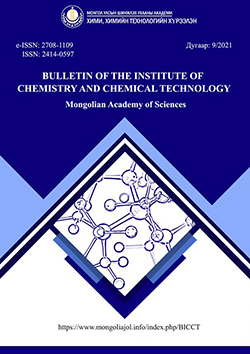Evaluation of biological activity and toxicity of extracts from Cuscuta chinensis
DOI:
https://doi.org/10.5564/bicct.v4i9.1817Keywords:
Brine shrimp, phenolic compound, flavonoid compound, holoparasitic plant, phytochemistryAbstract
As the world's population grows, so do the many infectious and non-communicable diseases that follow, and there is an urgent need to find ways to treat and cure them. In particular, it is very important to study low-toxic, highly therapeutic substances from natural raw materials such as plants, animals and microorganisms and introduce them for use as medicines and food supplements. In our study, we studied the chemical composition of Cuscuta chinensis grown in Mongolia and obtained a group of extracts to determine the DPPH free radical inhibitory activity and calculated the IC50 value for hexane extract 32.09 μg/ml, chloroform extract 31.35 μg/ml, ethyl acetate extract 7.23 μg/ml, n-butanol extract 53.35 μg/ml, aqueous extract 84.46 μg/ml, and chloroform extract S.aureus, P.aeruginosa, B.subtilis, ethyl-acetate extract S.aureus, P.aeruginosa, B.subtilis, E.faecalis were active in inhibiting the growth of bacteria. Also evaluated toxicity of extracts for Brine shrimp lethality assay.
Нангиад ороонго (Cuscuta chinensis Lam)-ын биологийн идэвх, хорон чанарын судалгаа
Хураангуй: Бид судалгаандаа Монгол оронд ургадаг Нангиад ороонго /Cuscuta chinensis/-ын химийн найрлагыг судлан, бүлэг хандуудыг гарган авч, DPPH чөлөөт радикал саатуулах идэвхийг тодорхойлон IC50 утгыг тооцоход гексаны ханд 32.09 мкг/мл, хлороформын ханд 31.35 мкг/мл, этил-ацетатын ханд 7.23 мкг/мл, н-бутанолын ханд 53.35 мкг/мл, усан ханд 84.46 мкг/мл утгатай буюу бусад бүлэг хандаас этил-ацетатын ханд нь хамгийн өндөр идэвхтэй, бактерийн эсрэг идэвхийг тодорхойлоход хлороформын ханд Staphylococcus aureus, Pseudomonas aeruginosa, Bacillus subtilis, этил-ацетатын ханд S.aureus, P.aeruginosa, B.subtilis, Enterococcus faecalis бактериудын өсөлтийг дарангуйлах идэвхтэй байв. Мөн хорон чанарыг Artemia salina хавчийн авгалдайд 1 мг/мл, 100 мкг/мл, 10 мкг/мл, 1 мкг/мл концентрацтайгаар тодорхойлон, LC50 утгыг тооцож Кларксоны хорон чанарын индексээр үнэлэхэд н-бутанолын ханд 1619.4 мкг/мл, усан ханд 1888.5 мкг/мл буюу хоргүй, харин гексаны ханд 212.15 мкг/мл, хлороформын ханд 432.47 мкг/мл, этил-ацетатын ханд 455.55 мкг/мл буюу дунд зэргийн хортой байв.
Түлхүүр үг: Brine shrimp, фенолт нэгдэл, флавоноид нэгдэл, шимэгч ургамал, ургамлын биохими.
Downloads
708
Downloads
Published
How to Cite
Issue
Section
License
Copyright (c) 2021 Janchivmaa Dorjbat, Myagmarsuren Byambadolgor, Baatarkhuu Amarjargal, Bazarvaani Nasantogtokh, Jigmed Sukhdolgor, Damdindorj Lkhagvasuren, Tuvaanjav Suvdmaa

This work is licensed under a Creative Commons Attribution 4.0 International License.
Copyright on any research article in the Bulletin of the Institute of Chemistry and Chemical Technology, MAS is retained by the author(s).
The authors grant the Bulletin of the Institute of Chemistry and Chemical Technology, MAS a license to publish the article and identify itself as the original publisher.

Articles in the Bulletin of the Institute of Chemistry and Chemical Technology, MAS are Open Access articles published under a Creative Commons Attribution 4.0 International License CC BY.
This license permits use, distribution and reproduction in any medium, provided the original work is properly cited.

